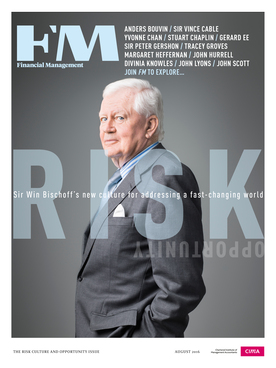Viable Options
The latest UK corporate governance code obliges listed companies to publish viability statements. Tom Teixeira, managing director of risk advisory services at Alvarez & Marsal, explains the key implications for boards.
This article first appeared in FM, the magazine of the Chartered Institute of Management Accountants (CIMA).

When the Financial Reporting Council updated its UK corporate governance code in 2014 to include a requirement on listed firms to publish a viability statement, there were many views about its possible impact.
Tom Teixeira, Managing Director of the risk advisory practice at global professional services firm Alvarez & Marsal, is better placed than most to give an informed opinion, because he has been conducting a research and consultation programme focusing on the viability statement and its development.
The FRC sees it as a means of ensuring that corporate boards properly understand the businesses they oversee, according to Teixeira. “With this in mind, risk should be moved beyond a process requirement to become a business plan contributor,” he says. “The viability statement helps to ensure that risk management is incorporated into the running of a business. This will help to remove the risk glass ceiling.”
Teixeira says that, while the changes to the code have been driven mainly by the 2007-08 financial crisis, they are highly-relevant to companies beyond the financial services sector, especially in industries that are subject to high levels of regulation.
“The broader commercial sector must come to terms with this increased reporting requirement and see it as an opportunity, not as extra red tape,” he says. “The guidance has been deliberately limited to let boards determine their own response. Clearer direction may be needed after the first three or so years of bedding in.”
Only a handful of firms have signed off on their viability statements to date, but most of the FTSE 350 will be doing so later this year. “The proactive ones show a clear link between the reporting of risk and the viability of their organisations,” he notes.
Too much information?

Teixeira, who has worked closely with CIMA, the Chairmen’s Forum and risk managers’ association Airmic in his research, observes that there is a degree of nervousness among boards about the amount of information they are expected to disclose in a viability statement. With this in mind, he says: “Excessive transparency in reporting risk can be dangerous and lead to negative consequences. Leaders therefore need to make a judgment call on what should be reported.”
Boards have to satisfy themselves that their risk management efforts are effective and not merely a box-ticking exercise, he stresses. “Board members need to consider the challenges they must be issuing to receive assurances. Their questions should include: who are the executive risk owners? What does good look like in order to meet the objective of linking risks and opportunities to our business plan? And is there a monitoring and control mechanism in place to achieve this aim?”
Teixeira believes that, although tangible risks are generally well understood, boards must gain a better view and understanding of less tangible risks in an era of increasing connectivity and -complexity. He believes that a wide array of factors – including -globalisation, environmental degradation, technological -disruption, sociopolitical upheaval and declining public trust in big business – should be a growing concern for corporate leaders.
“The key is to manage risk, so boards must simply equip themselves better to do so,” he argues. “Getting the culture of an organisation right is vital for the effective management of risk – and culture starts at the top. In this respect, all aspects need to be aligned.”

